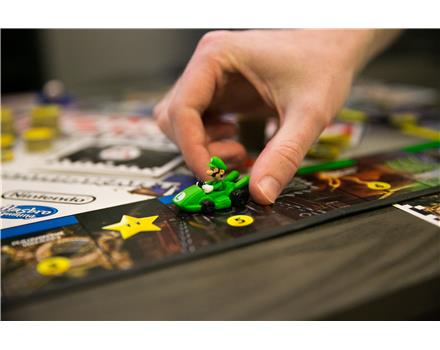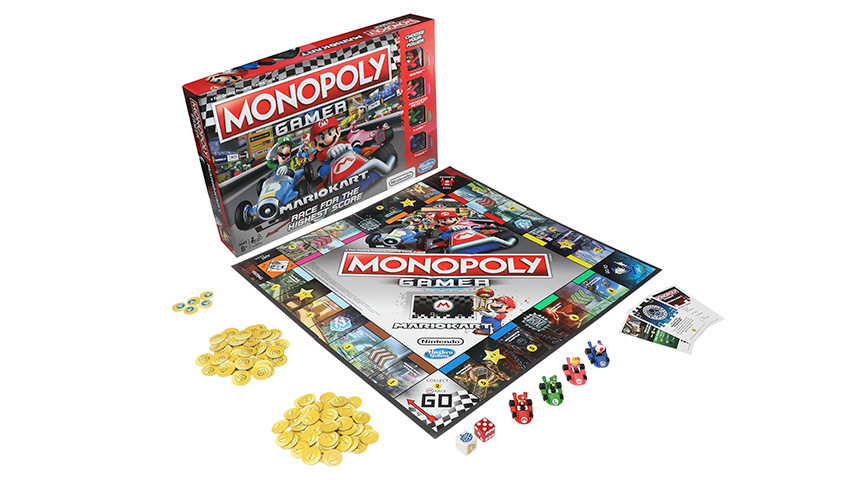When Monopoly Gamer was released last summer, it at first appeared to be just another rebranding of the classic “fast-paced property trading” game, only this time aimed at appealing to fans of classic Super Mario Bros. As it turned out, however, Monopoly Gamer offered a novel spin on the tried-and-true formula, and even if it didn’t manage to forever dethrone vanilla Monopoly, it provided an interesting and somewhat faster-paced take on the classic formula.
This spring, Hasbro has again teamed up with Nintendo for the second entry in the Monopoly Gamer series. However, this incarnation’s theme revolves around everybody’s favorite kart racer. In Monopoly Gamer: Mario Kart, two to four players start off by choosing their kart racer (current options include Mario, Luigi, Princess Peach, and Toad, with additional racers to become available — for an additional price — at a later date).
Your choice of kart racer is actually a more strategic decision than picking between tokens in traditional Monopoly since each racer has its own unique Power-up Ability that is activated by landing on one of the board’s Super Star spaces. Mario, for example, gets to collect three coins each time, whereas Toad can choose to drop up to five coins and move forward the same amount of spaces.
Rather than starting off with boatloads of pastel-colored paper bills, you begin with 10 coins, and you’ll spend most of the game slowly moving around the circuit, purchasing or paying rent for landing on Mario Kart-themed properties, such as Rainbow Road and Moo Moo Meadows. You roll two dice, but one of them is a Power-Up die. What this means is that you’ll move anywhere from one to six spaces a turn but also activate one of six Mario Kart-themed abilities every time.
Maybe you’ll roll a Green Shell and force an opponent to drop coins on whatever property they happen to be sitting on, or perhaps you’ll roll Coins and simply collect three coins from the bank. Whatever the case may be, you’ll be dropping and picking up coins on just about every turn.
Once you’ve finally made it all the way around the board (which, despite having fewer spaces to cover, still takes a while since you only use one die to move), you pass GO and flip over a Grand Prix card. This starts a race that each player can voluntarily enter by paying a few coins as an entry fee. Far removed from the high-octane action of the video game series, these races require you to simply outroll your opponents. There are prizes for first, second, and third places, and the winner also holds on to the Grand Prix card, which is also worth points.
Unlike old-school Monopoly, this game doesn’t end once a single player has managed to bankrupt his or her (possibly former) friends and family members. After the final Grand Prix race has run, players tally up the points they’ve accumulated from properties owned, Grand Prix race cards collected, and coins amassed. Then, just like always with Monopoly, one person walks away bragging while the others vow to never again play a board game with the winner.
Image courtesy of GameStop
For the most part, I enjoyed my time with Monopoly Gamer: Mario Kart, but I nevertheless have a few gripes with the game.
To start, there’s no Yoshi available upon launch, and asking me to pay $2.99 down the line for a “Power Pack” so that I’m not stuck with Luigi again strikes me as a little too similar to what we’re seeing in the video gaming world right now.
Secondly — and perhaps due to some anomaly in my own playthrough — it seems like there should be far more single coins available. By game’s end, my group and I still had a sizable stack of the five-cent cardboard punch-outs but had resorted to using actual pennies in lieu of the one-cent pieces. I haven’t seen this complaint elsewhere, though, so maybe this isn’t happening to others.
Finally, with all the focus on power-ups, dropping banana peels, and coin exchanging, my favorite part of Monopoly seemed lost in the shuffle: Only two or three times did I get to giddily demand that my loved ones “PAY UP!” when landing on my property. There aren’t any houses or hotels, and every time I managed to land on a property I wanted to purchase, I was too broke to purchase it (largely because I was getting Thwomped and barraged by Spiny Shells on nearly every turn).
Monopoly Gamer: Mario Kart is a unique take on a formula that somehow hasn’t really grown tired even after all these years. It deserves its place in the gigantic pantheon of Monopoly games, and I have to give it credit for not just being yet another rebranded version. But at the end of the day, I’d probably rather just horde railroads, open Community Chests, and stick with the classic.
Monopoly Gamer: Mario Kart is available now at GameStop, with plans to extend to other retailers this summer.







Published: Apr 26, 2018 12:16 pm